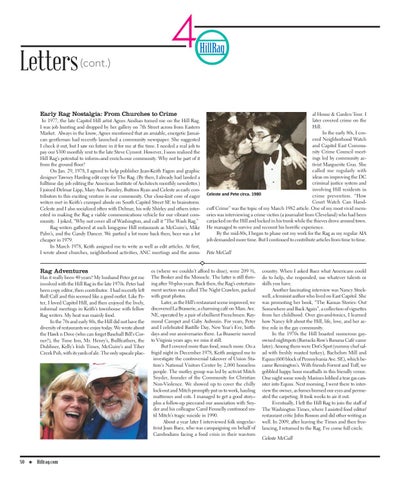Letters
(cont.)
Early Rag Nostalgia: From Churches to Crime
In 1977, the late Capitol Hill artist Agnes Ainilian turned me on the Hill Rag. I was job hunting and dropped by her gallery on 7th Street across from Eastern Market. Always in the know, Agnes mentioned that an amiable, energetic Jamaican gentleman had recently launched a community newspaper. She suggested I check it out, but I saw no future in it for me at the time. I needed a real job to pay our $300 monthly rent to the late Steve Cymrot. However, I soon realized the Hill Rag’s potential to inform--and enrich--our community. Why not be part of it from the ground floor? On Jan. 29, 1978, I agreed to help publisher Jean-Keith Fagon and graphic designer Tawney Harding edit copy for The Rag. (By then, I already had landed a fulltime day job editing the American Institute of Architects monthly newsletter.) I joined Delmar Lipp, Mary Ann Parmley, Buttons Ryan and Celeste as early contributors to this exciting venture in our community. Our close-knit core of eager writers met in Keith’s cramped abode on South Capitol Street SE to brainstorm. Celeste and I also socialized often with Delmar, his wife Shirley and others interested in making the Rag a viable communications vehicle for our vibrant community. I joked, “Why not cover all of Washington, and call it “The Wash Rag.” Rag writers gathered at such long-gone Hill restaurants as McGuire’s, Mike Palm’s, and the Gandy Dancer. We partied a lot more back then; beer was a lot cheaper in 1979. In March 1978, Keith assigned me to write as well as edit articles. At first, I wrote about churches, neighborhood activities, ANC meetings and the annu-
Rag Adventures
Has it really been 40 years? My husband Peter got me involved with the Hill Rag in the late 1970s. Peter had been copy editor, then contributor. I had recently left Roll Call and this seemed like a good outlet. Like Peter, I loved Capitol Hill, and then enjoyed the lively, informal meetings in Keith’s townhouse with fellow Rag writers. My beat was mainly food. In the 70s and early 80s, the Hill did not have the diversity of restaurants we enjoy today. We wrote about the Hawk n Dove (who can forget Baseball Bill’s Corner?), the Tune Inn, Mr. Henry’s, Bullfeathers, the Dubliner, Kelly’s Irish Times, McGuire’s and Tiber Creek Pub, with its yards of ale. The only upscale plac-
50 H Hillrag.com
al House & Garden Tour. I later covered crime on the Hill. In the early 80s, I covered Neighborhood Watch and Capitol East Community Crime Council meetings led by community activist Marguerite Gras. She called me regularly with ideas on improving the DC criminal justice system and involving Hill residents in Celeste and Pete circa. 1980 crime prevention. “How Court Watch Can Handcuff Crime” was the topic of my March 1982 article. One of my most vivid memories was interviewing a crime victim (a journalist from Cleveland) who had been carjacked on the Hill and locked in his trunk while the thieves drove around town. He managed to survive and recount his horrific experience. By the mid-80s, I began to phase out my work for the Rag as my regular AIA job demanded more time. But I continued to contribute articles from time to time. Pete McCall
es (where we couldn’t afford to dine), were 209 ½, The Broker and the Monocle. The latter is still thriving after 50-plus years. Back then, the Rag’s entertainment section was called The Night Crawlers, packed with great photos. Later, as the Hill’s restaurant scene improved, we discovered La Brasserie, a charming café on Mass. Ave. NE, operated by a pair of ebullient Frenchmen: Raymond Campet and Gaby Aubouin. For years, Peter and I celebrated Bastille Day, New Year’s Eve, birthdays and our anniversaries there. La Brasserie moved to Virginia years ago; we miss it still. But I covered more than food, much more. On a frigid night in December 1978, Keith assigned me to investigate the controversial takeover of Union Station’s National Visitors Center by 2,000 homeless people. The motley group was led by activist Mitch Snyder, founder of the Community for Christian Non-Violence. We showed up to cover the chilly lock-out and Mitch promptly put us to work, hauling mattresses and cots. I managed to get a good story– plus a follow-up pieceand our association with Snyder and his colleague Carol Fennelly continued until Mitch’s tragic suicide in 1990. About a year later I interviewed folk singer/activist Joan Baez, who was campaigning on behalf of Cambodians facing a food crisis in their war-torn
country. When I asked Baez what Americans could do to help, she responded, use whatever talents or skills you have. Another fascinating interview was Nancy Stockwell, a feminist author who lived on East Capitol. She was promoting her book, “The Kansas Stories: Out Somewhere and Back Again”, a collection of vignettes from her childhood. Over gin-and-tonics, I learned how Nancy felt about the Hill, life, love, and her active role in the gay community. In the 1970s the Hill boasted numerous gayowned nightspots (Barracks Row’s Banana Café came later). Among them were Dot’s Spot (yummy chef salad with freshly roasted turkey), Bachelors Mill and Equus (600 block of Pennsylvania Ave. SE), which became Remington’s. With friends Forrest and Tuff, we gobbled happy hour meatballs in this friendly venue. One night some rowdy Marines lobbed a tear gas canister into Equus. Next morning, I went there to interview the owner, as fumes burned our eyes and permeated the carpeting. It took weeks to air it out. Eventually, I left the Hill Rag to join the staff of The Washington Times, where I assisted food editor/ restaurant critic John Rosson and did other writing as well. In 2009, after leaving the Times and then freelancing, I returned to the Rag. I’ve come full circle. Celeste McCall
